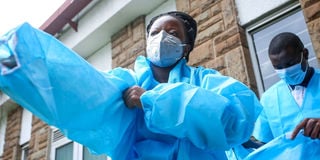For medical students, online learning is not the solution

University of Nairobi medical student Bethtryl Akinyi wears personal protective equipment during the handover of the gear to the final year medical and dental students at Kenyatta National Hospital’s Mbagathi Infectious Disease Unit.
What you need to know:
- Most outpatient clinics shut down, doing away with nearly 15,000 patients daily.
- The imposed lockdowns resulted in reduced travel in search of medical care.
- It was left to the poor students to ensure their own safety by acquiring their own personal protective equipment.
The year is 2021 and our children are back to school, learning under trees and make-shift canopies in an effort to maintain some level of social distancing to prevent the spread of Covid-19.
But, the quality of education acquired remains a hotly contested debate on many fronts.
While we deal with the challenges of ensuring the continuity of basic and secondary education, we may be grossly overlooking higher education.
While many university and college courses have managed to successfully transition to remote learning, the highly technical courses will never be able to do so. This means the challenges occasioned by Covid-19 grossly interfere with the quality of training.
Services suspended
Let me speak specifically about my own backyard, health. The training of doctors, nurses and clinical officers is fully dependent on a functioning health system. The wards are their lecture halls. In clinical training, 70 per cent of the learning goes on with the patient as the basic learning tool.
For instance, at Kenyatta National Hospital, our largest and oldest national teaching hospital, there are over 5,000 students rotating there in any given day, learning.
They include students from University of Nairobi; basic and post-basic level trainees from Kenya Medical Training College; nurse trainees from multiple public and private nursing schools across Kenya and many foreign-trained doctors familiarising themselves with medicine in Kenya.
This is only possible when the hospital’s 1,800-bed capacity is full to the brim, the dozens of outpatient clinics are running at full function and the accident and emergency department is on full throttle. This means nearly 20,000 patients are attended to on any single day, providing a vibrant learning environment for the various cadres of students present.
This is replicated at the Moi Teaching and Referral Hospital on a similar scale and in the multiple teaching hospitals across the country on a smaller scale.
With the pandemic, hospital functioning has been disrupted. The initial period of Covid-19 incidence in Kenya led to disruption of services as all non-essential services were suspended.
This means most outpatient clinics shut down, doing away with nearly 15,000 patients daily. As most patients are admitted through the outpatient clinics for planned procedures and surgeries, the wards became empty. The imposed lockdowns resulted in reduced travel in search of medical care.
As a result, the learning resources for students in the various healthcare professions was inadvertently taken away and the institutions were closed in line with the public health directive. Many tertiary level institutions moved their teaching online over time but this would never be a feasible option for health related courses.
As some institutions were justifying re-opening of the medical schools, it was left to the poor students to ensure their own safety by acquiring their own personal protective equipment, which was not feasible to many needy students. Their ward rotations were also affected by the upsurge of industrial action, both from their lecturers and from hospital staff.
Weeks of strikes
What is even more appalling is the fact that these inadequately trained young doctors are now being released for internship, the final step in the training before full registration to practise independently in Kenya. Why is this so? Because the majority of internship centres in Kenya are county hospitals. And the past few months have exposed just how failed the health systems in the counties are.
Mombasa County doctors have been on strike for two months now. The county response has been to fire them all.
Laikipia County has not had specialist doctors for more than a year now, as a result of unresolved industrial disputes and lack of commitment to employ the requisite specialists for the purposes of internship training. Across the country, nurses have been on strike for weeks, yet any health administrator worth their salt should know that nothing, absolutely nothing, moves in a hospital without nurses, irrespective of whomever else is at work.
The ripple effect of the currently failed public health system will be felt by all of us for generations to come. The fact that 90 per cent of Kenyans cannot access quality health care today, translates to a doomed future.
You may have access to the best facilities but during an emergency, if the hospital near you is not functioning, you will not live long enough to make it to your facility of choice.



